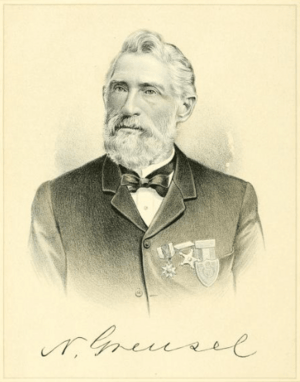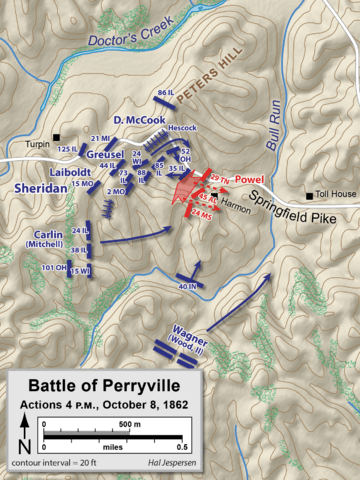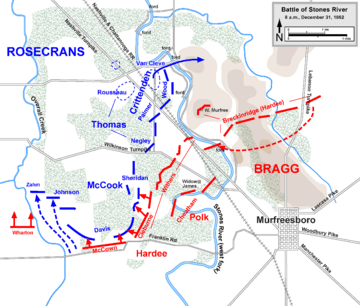Nicholas Greusel facts for kids
Quick facts for kids
Nicholas Greusel
|
|
|---|---|

Nicholas Greusel
|
|
| Born | July 4, 1817 Blieskastel, Kingdom of Bavaria |
| Died | April 25, 1896 (aged 78) Mount Pleasant, Iowa |
| Buried | |
| Allegiance | |
| Service/ |
Union Army |
| Years of service | 1861–1863 |
| Rank | |
| Commands held |
|
| Battles/wars |
|
| Other work | Detroit Alderman (1844–46) |
Nicholas Greusel (born July 4, 1817 – died April 25, 1896) was an important military leader. He commanded the 36th Illinois Infantry Regiment during the early years of the American Civil War. As a teenager, he moved from the Kingdom of Bavaria (part of modern-day Germany) to the United States.
He later lived in Detroit, where he was elected to a political job. Greusel led a group of Michigan volunteers during the Mexican–American War. After that, he moved to Illinois. When the Civil War began, he joined an Illinois regiment. He quickly became a high-ranking officer. The state governor then made him a colonel of the 36th Illinois.
Colonel Greusel led a large group of soldiers, called a brigade, in several major battles. These included the Pea Ridge, the Siege of Corinth, and the Perryville. At the Battle of Stones River, he took command of his brigade when its leader was killed. He later left the army due to poor health. After the war, he worked for a railroad company. In his later years, he became a strong believer in pacifism, which means opposing war and violence.
Contents
Early Life and Career
Nicholas Greusel was born on July 4, 1817, in Blieskastel. This town was then part of the Kingdom of Bavaria. He learned to speak both German and French language as a child. In 1833, when he was 16, his family moved to New York City in the United States.
His father told Nicholas and his older siblings they had to make their own way. Nicholas found work for a year with the mother of a famous politician, Hamilton Fish. Then he worked in a brickyard for another year. His whole family later moved again. They arrived in Detroit, Michigan Territory on November 1, 1836.
Greusel found a job in the lumber business. He worked there for the next ten years. During this time, he became a captain in a local army, called a militia. Later, he became a major in the Frontier Guards. In 1839, Greusel married Jane Doumens. They had 12 children together, but only eight were still living in 1888. In 1844, he was elected as an Alderman for Detroit's Fourth Ward. He was a member of the Whig Party and served for two years.
Serving in the Mexican-American War
When the Mexican–American War started, Greusel gathered a group of volunteers. He was chosen as captain of this group. They became Company D of the 1st Michigan Regiment. His company traveled by foot, train, and boat to Veracruz, Mexico. They arrived ten days after the Siege of Veracruz ended.
The regiment served under General James Monroe Bankhead. They were in the area around Orizaba and Córdoba. They often had small fights with Mexican guerillas and soldiers. When the war ended, the regiment returned home. They arrived in Detroit on July 12, 1847.
Out of 105 soldiers in Company D, 85 returned home. This was a better survival rate than other companies. Greusel was good at managing the company's money. He saved $300, which he used to buy new shirts and shoes for his soldiers. Because Company D looked so sharp, the regiment's colonel put them at the front of the homecoming parade.
Life Before the Civil War
Soon after the war, Greusel was elected major. Then he became a lieutenant colonel of the city guards. In 1849, he became the superintendent of Detroit's water works. From 1850 to 1852, he was the Inspector General of lumber for Michigan.
Around this time, Greusel made a bad investment. He lost all his life savings. For the next few years, he worked as a conductor for the Michigan Central Railroad. Later, he moved to Aurora, Illinois. There, he got a job with the Chicago, Burlington and Quincy Railroad.
On April 18, 1861, after the Battle of Fort Sumter, Captain Greusel joined the Illinois militia. His Aurora Company signed up for three months of service. On April 25, his company joined the 7th Illinois Infantry Regiment. Greusel quickly rose to the rank of lieutenant colonel in this regiment. On August 14, Governor Richard Yates made Greusel a colonel. He was put in charge of the "Fox River Regiment," which became the 36th Illinois Infantry.
Civil War Service
Battles at Pea Ridge and Corinth
At the Battle of Pea Ridge on March 7–8, 1862, Colonel Greusel led the 2nd Brigade. This brigade was part of the 1st Division under General Peter Joseph Osterhaus. Their division was part of the Army of the Southwest, led by General Samuel Ryan Curtis. Greusel's brigade included the 36th Illinois, the 12th Missouri Volunteer Infantry, and two Illinois cavalry companies.
On March 7, General Curtis learned that the Confederate army was trying to attack from behind. He ordered Osterhaus and Greusel to move quickly. When Union cavalry soldiers ran away in a panic, Greusel shouted to his men. He told them, "Officers and men, you have it in your power to make or prevent another Bull Run affair. I want every man to stand to his post." His soldiers stayed calm and did not panic.
Greusel calmly directed his troops to set up their defenses. They used their two regiments and several cannons. When the 6th Texas Cavalry Regiment suddenly charged, Greusel's men fired quickly. This forced the Texans to retreat. Greusel also ordered cannons to fire shells over the woods. This "blind fire" surprisingly scared the Confederate's Native American allies.
Greusel sent a small group of skirmishers forward. These soldiers from the 36th Illinois shot and killed Confederate General Benjamin McCulloch. He was scouting the area. When the skirmishers were attacked, Greusel ordered the 36th Illinois to rescue them. The regiment fired many shots, killing General James M. McIntosh. The loss of two top generals caused the Confederate attack to fall apart. This helped the Union win that day.
On March 8, both armies fought near Elkhorn Tavern. Union General Franz Sigel used 21 cannons to bombard the Confederates. Greusel narrowly avoided being hit by a cannonball. It knocked him off his horse, but he was not badly hurt. As the Confederates weakened, the Union infantry charged forward. Greusel's two regiments were at the front. The 36th Illinois lost 75 soldiers killed, wounded, or missing. The 12th Missouri lost 34.
From June to September 1862, Greusel commanded the 1st Brigade. This was part of the 5th Division of the Army of the Mississippi. During this time, his unit was involved in the Siege of Corinth.
Key Battles: Perryville and Stones River
At the Battle of Perryville on October 8, 1862, Greusel led the 37th Brigade. This brigade was part of General Philip Sheridan's 11th Division. His brigade included the 36th Illinois, 88th Illinois, 21st Michigan, and 24th Wisconsin Regiments.
In the late afternoon of October 7, Greusel's brigade helped Union cavalry. This forced Confederate horsemen to pull back. On October 8, three Confederate regiments attacked Sheridan's division. The 36th Illinois suddenly stood up and fired, stopping them cold. A fierce firefight happened across a cornfield. The 36th Illinois ran out of ammunition and had to pull back.
Sheridan moved the 24th Wisconsin to the far left. The Confederate line soon broke apart after losing many soldiers. The 21st Michigan stayed behind to support the cannons.
At the Battle of Stones River from December 31, 1862, to January 2, 1863, Greusel commanded the 36th Illinois. They were part of General Joshua W. Sill's 1st Brigade. This brigade was in Sheridan's 3rd Division. The regiments were the same as at Perryville. The brigade suffered many losses: 104 killed, 365 wounded, and 200 missing.
On the morning of December 31, five Union brigades were running away in panic. Around 7:00 am, Sheridan's division came under attack. The 24th Wisconsin broke apart quickly, leaving a gap next to the 36th Illinois. When the 19th Alabama came very close, the Illinois soldiers fired a powerful volley. For half an hour, the two regiments fought fiercely. Then the 19th Alabama began to move backward. Greusel ordered a counterattack with bayonets, forcing the Confederates to retreat.
During this first fight, General Sill was killed. Greusel immediately took over leadership of the brigade. For 90 minutes, Sheridan's three brigades fought seven Confederate brigades. This was called "the most determined stand of the entire war." At 8:00 am, the last of the Confederate brigades was finally forced to retreat.
The 36th Illinois ran out of ammunition. They were given permission to pull back. They had lost 46 killed, 151 wounded, and 15 missing. Sheridan moved his troops to a second position. He sent the 88th Illinois and 21st Michigan to hold a spot near the Harding farm. Around 10:00 am, Sheridan had to order a retreat because his soldiers had no ammunition left.
Later, General McCook ordered Greusel to withdraw without talking to Sheridan. This badly timed order caused the Union to lose six cannons. At 2:00 pm, the 36th Illinois took a reserve position near the Round Forest.
On January 2, 1863, after days of fighting and no sleep, Sheridan and Greusel tried to sleep in a rough shelter. The next morning, they woke up covered in snow. Greusel could not move because of his rheumatism (a painful joint condition). He resigned from the army on February 7, 1863.
Some sources say Greusel was promoted to brigadier general after Stones River. This was recommended by General William Rosecrans. After the war, General Sheridan wrote a very nice letter to Greusel. He thanked him for his service. Greusel was also given a silver-plated revolver. It was for having the best-drilled regiment in the army.
Life After the War
After leaving the army, Greusel went back to working as a conductor. He worked for the Chicago, Burlington and Quincy Railroad. On September 1, 1866, he moved to Burlington, Iowa. He took a new job as Roadmaster for the Burlington and Missouri River Railroad. In January 1867, he moved again to Mount Pleasant, Iowa. He worked for the railroad for three years, then he retired.
In 1888, he was a church official at Saint Michael's Episcopal Church in Mount Pleasant. Greusel and his wife had 12 children. Eight of them were still living in 1888. Their names were E. Stuyvesant, Josephine, Elizabeth, Rachel, John O., Nettie, Susie, and Philip Sheridan. Another son, Joseph, joined the army and was killed in 1863.
In 1876, there was a peace meeting in Philadelphia. Someone suggested turning swords into useful tools. Greusel was the first to step forward. He offered to donate his own sword. He said it was the sword he carried in both the Mexican-American War and the Civil War. He had planned to give it to his children.
Greusel's sword was turned into a pruning hook. This is a tool used for cutting plants. It was shown at the conference the next day. After the war, Greusel became a strong supporter of peace. He believed in ending wars by getting rid of weapons. Nicholas Greusel died in Mount Pleasant on April 25, 1896. He was buried in Aurora, Illinois, at Spring Lake Cemetery. His gravestone reads "GENERAL N. GREUSEL."



